What is Inbox Zero?
Inbox Zero is pretty much what it sounds like—having zero emails in your inbox. While this can be a huge undertaking, the point is to minimize the number of unread messages and those that require additional actions. In the end, you’ll have an organized and up-to-date mailbox.
When you achieve a Zero Inbox in Outlook, you’ll have more time to focus on important tasks. You’ll also spend less time worrying about replying to emails or forgetting to respond at all.
Wondering how to use Outlook effectively to achieve this goal? Keep reading to learn how to reach Inbox Zero in Outlook.
How to Get to Inbox Zero in Outlook
To get your Outlook inbox to zero, try and test a few different methods to see which work best for you. You may tweak the following suggestions to suit your specific needs, but if one or more work, then you may finally reach Inbox Zero!
The Four D’s – Do, Delegate, Defer, or Delete
You’ll see many productivity experts recommend the four D’s as an Inbox Zero method. When you receive a message, perform an “email triage.” Decide if you should Do it, Delegate it, Defer it, or Delete it.
Do: If the email will take only a few minutes to act on, then deal with it right away. You can also reply faster and more efficiently if you create and use email templates as we’ll describe below.
Delegate: If the email should go to a coworker or a team member to act on, forward it to them. You can then move the message to a folder or create a rule to do it for you after you forward it.
Defer (or Delay): If you need more time to respond to or act on an email, defer it. You can then use one of Outlook’s features such as snoozing the message or flagging it for follow up.
Delete: Delete any unnecessary emails, mark spam to send it to Junk, or unsubscribe immediately. You can follow the guides below to mark spam and unsubscribe. You can also see how Clean Email can help you bulk delete Outlook messages.
To go along with the four D’s as your Zero Inbox method in Outlook, here are several tips and step-by-step guides to help you stick to your email triage.
1. Pin Important Messages
Outlook provides a useful feature to help you remember important emails. When you pin a message, this moves it to the top of your inbox. Once you take the necessary action on the email, you can unpin it and it’ll return to its original spot.
To pin a message on Outlook.com, select the email and do one of the following:
- Select the Pin button on the right in the message list.
- Click the Pin button in the top toolbar.
- Right-click and pick Pin.
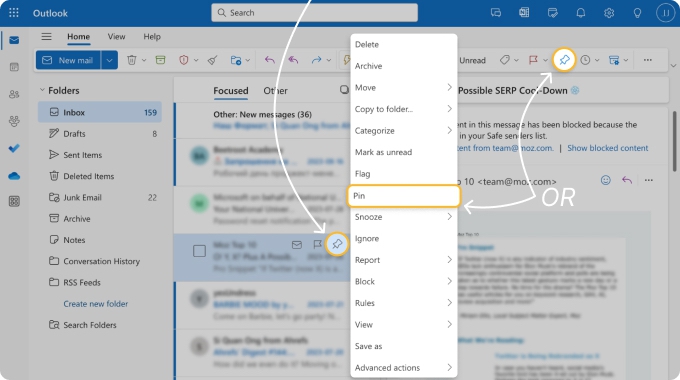
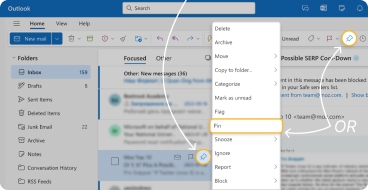
Also, make sure to sort your email list by date to see pinned emails at the top. Select Filter on the top right, move to Sort, and pick Date.
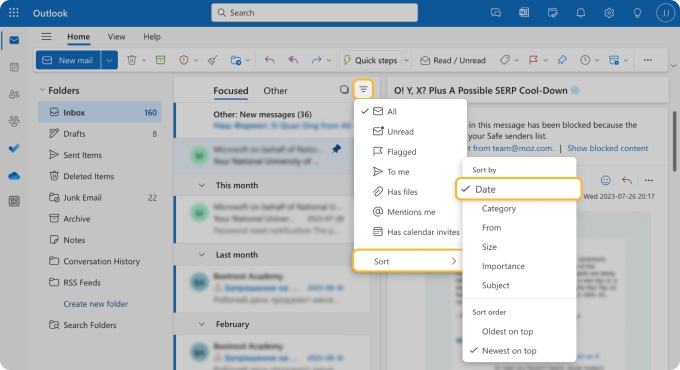
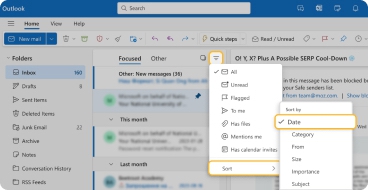
2. Flag Emails as They Arrive
Another way to make important messages stand out is to flag them. Unlike pinning an email, you can add a flag in Outlook that automatically reminds you of the message for the time you select.
To flag an email for today in Outlook, select the message and do one of the following:
- Select the Flag button on the right in the message list.
- Right-click and pick Flag.
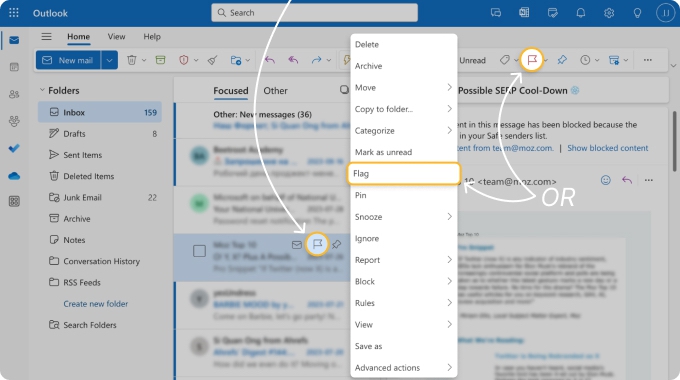
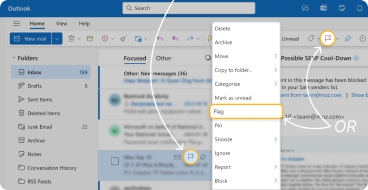
To flag an email for a different day, select the message, open the Flag menu in the top toolbar, and choose the timeframe.
3. Mark and Move Spam Emails
Before you get stuck deleting tons of unsolicited emails, mark them as spam first. This helps Outlook identify which emails are spam and then mark them for you automatically moving forward. Plus, messages marked as spam move straight to the Junk folder for you.
To mark a message as spam in Outlook, select the email and do one of the following:
- Open the Report menu in the top toolbar and pick Report junk.

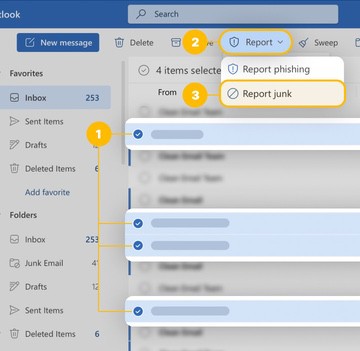
- Right-click, choose Report, and pick Report junk.
- Drag the message to the Junk Email folder in the left-hand menu.
If you have the email open, you can also click the three dots on the top right of it, move to Report, and pick Report junk.


Check out our other post about how to stop junk email in Outlook.
4. Unsubscribe From Mailing Lists
Another way to get closer to Inbox Zero with Outlook is to unsubscribe from mailing lists. For promotional emails and newsletters you no longer want, unsubscribe to stop these messages from entering your inbox.
- To unsubscribe from an email in Outlook, open the message.
- Select Unsubscribe above the email header.
- Click OK in the pop-up window to confirm.
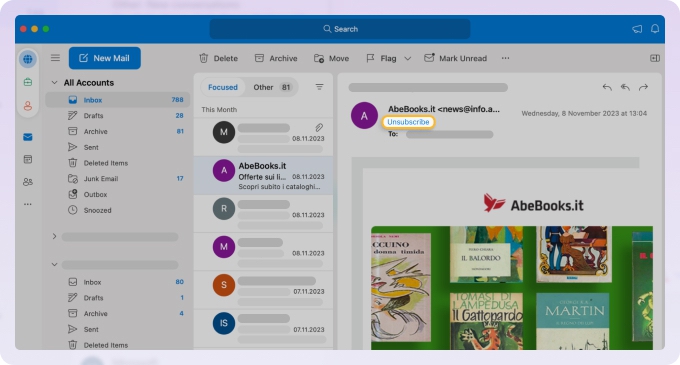

You can also view other subscriptions and unsubscribe in Outlook by following our complete guide.
5. Use Email Templates
For both replies and new messages, take advantage of the email template feature in Outlook. Even though when you reply to a message, you can keep it short and to the point, you can save time and increase your productivity with Outlook email templates.
- To compose a template in Outlook, create a new message and open the More options menu (three dots) or search Apps (square button) and select My Templates.
- Click +Template.
- When the box appears, enter your message and pick Save.



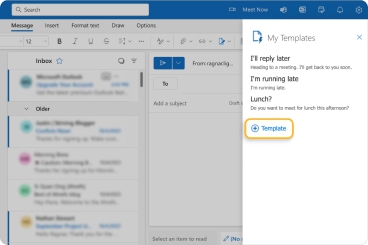
To use a template you create, follow the same steps to open the My Templates list and choose a template.
6. Set Up Folders
Some experts say that creating folders for emails is a waste of time and simply makes you feel organized. But there are many people who find that using folders is an efficient and effective organizational method.
If you want to create folders in Outlook to either manually or automatically move emails to them, here are a few that can make your email life easier.
- Action Required: You need to act on these emails first or by the end of the day.
- Awaiting Response: You replied to these emails and are awaiting replies.
- Delegated: You forwarded these emails to others for action.
You can also create other folders depending on your business or personal needs.
- To create a folder in Outlook, expand Folders in the left-hand menu.
- At the bottom of the folder list, choose Create new folder.
- Name the folder and click Save.


7. Create Inbox Rules
One of the simplest ways to achieve Outlook Inbox Zero is to use rules which automatically move emails to folders or flag messages for follow up. Not only can rules save you time, but help you create an organized inbox without lifting another finger.
- To create a rule for a sender in Outlook, open the email and click More options (three dots) on the top right of the message.
- Choose Create rule, then pick a folder to move the email to in the drop-down list.
- For other conditions and actions, select More options instead.
- Click OK to save the rule and optionally run the rule immediately.
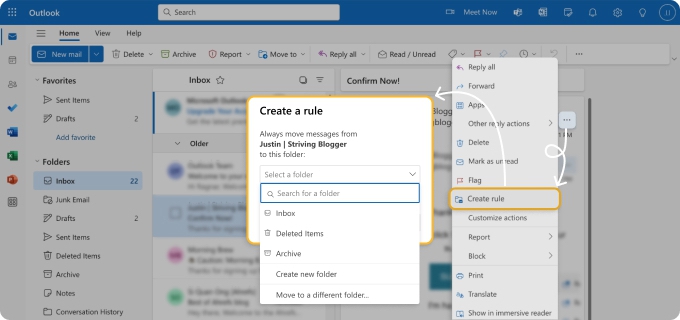

For more, read our complete guide on Outlook rules or check out our video on how to create rules in Outlook.

8. Set Up Time Blocks to Manage Emails
Time blocking is a method of time management that has its benefits if you stick to it. Basically, you set up specific times of the day to take care of tasks. And you can go as far as blocking your calendar and receiving reminders for each time block.
Consider creating one or more time blocks throughout the day for managing emails. For example, you might set aside 30 minutes in the morning and again in the afternoon.
- To add an email time block to Outlook, select the Calendar button on the left.
- Choose New event on the top left.
- Add a title, choose the start and end times, and use the Don’t repeat drop-down box to pick Daily.
- To display a status such as Busy or add a reminder, use the drop-down boxes in the top toolbar.
- Optionally select a calendar on the top left if you have more than one.
- Click Save.

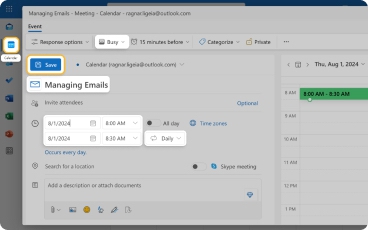
9. Use a Mailbox Helper
One final way to achieve Outlook Inbox Zero is to get a bit of help. Using an application like Clean Email, you can mark emails as spam, unsubscribe, create rules, and use Smart Folders to automatically sort messages, all with more flexibility and control.
How to Clean Your Mailbox with Clean Email
You can use Clean Email with your Outlook account and enjoy the same features both on the web and your mobile device. Plus, Clean Email provides you with a safe and secure inbox and robust features for reaching Inbox Zero in Outlook.
Let’s take a look!
Unsubscribe in Bulk
With Clean Email, you can start by controlling subscriptions using the Unsubscriber. This lets you easily opt out from all unwanted subscriptions at once rather than one by one.
- Select Unsubscriber in the left-hand menu and do one of the following:
- For a single email, click Unsubscribe to the right.
- For multiple emails, click Select at the top and then mark the message or pick Select All. Then, choose Unsubscribe at the bottom.
- Optionally turn on the toggle to move existing messages to the Trash as well and click Confirm.

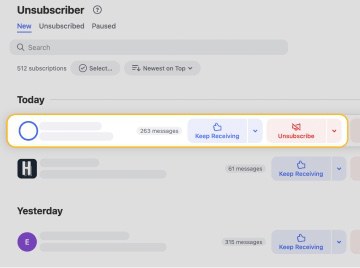
Set Up Rules with Auto Clean
Auto Clean allows you to move emails from certain senders to Trash, archive social media notifications, send emails to their relevant folders, and much more.
- Select Auto Clean in the left-hand menu and click the plus sign or Create Rule button on the right.
- Use the drop-down boxes and buttons at the top to choose the conditions such as from a specific sender, domain, or old emails.
- Use the drop-down box at the bottom to choose the action such as moving to a folder, marking as read, or moving to Trash.
- Optionally turn on the toggles for adding the rule to Action History and applying it to existing messages.
- Click Create Rule to finish.
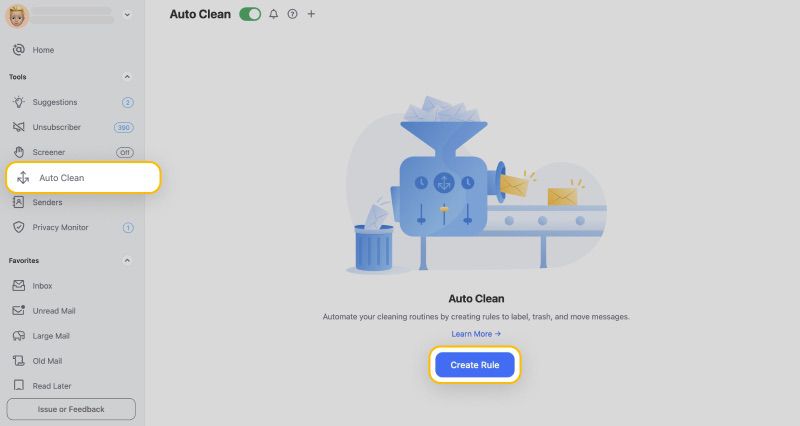

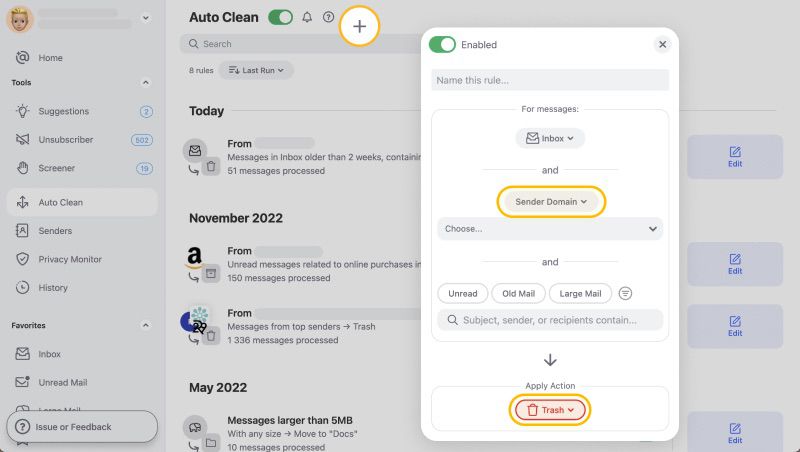

Delete Multiple Emails with Smart Folders
Want to delete Outlook emails in bulk? With Smart Folders, Clean Email automatically sorts messages into premade folders for you. For example, you have Smart Folders for Social Notifications, Seasonal Sales, and Online Shopping. You can then delete all emails you no longer want at once.
- Expand Smart Folders in the left-hand menu and choose a folder.
- Optionally, use the tools at the top if you want to quickly find Unread messages, Old Mail, or Large Mail.
- Click Select and then mark the messages or pick Select All.
- Choose Delete at the bottom to permanently remove the emails or Trash to move them to the trash folder.
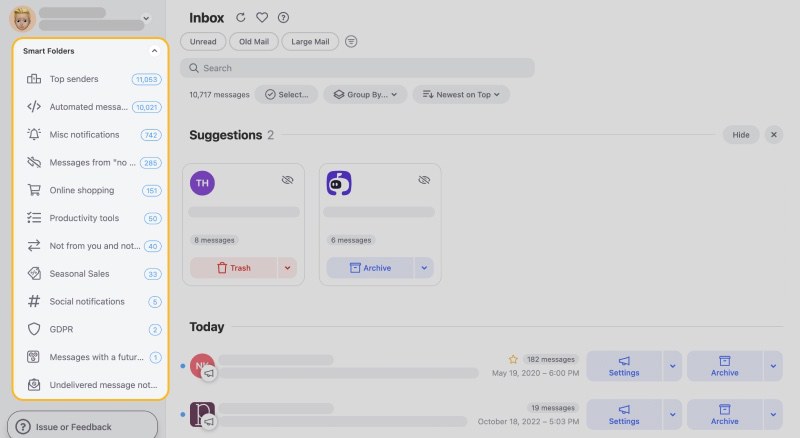
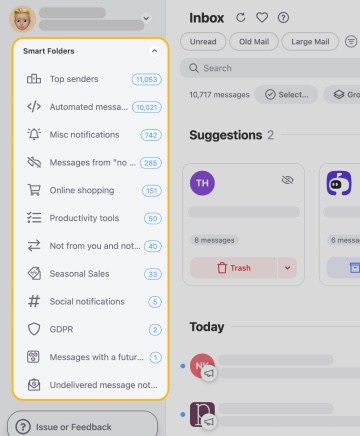
Additional Clean Email Features
The following Clean Email features are also super handy for achieving Outlook Inbox Zero and giving you a clean Outlook inbox.
- Move emails to Read Later which is a space for you to read emails when you are ready.
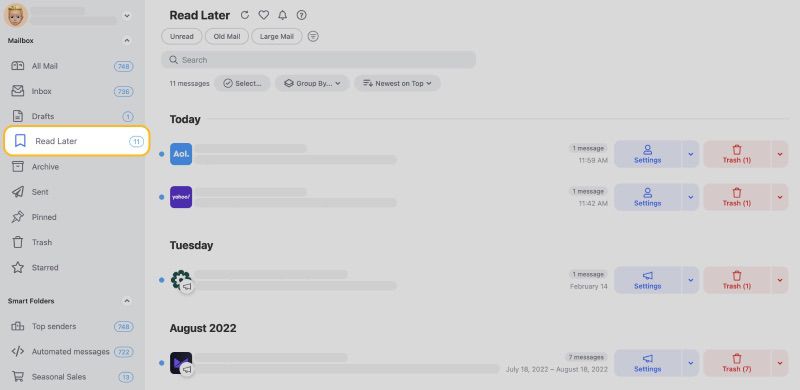

- Use Cleaning Suggestions to archive emails or move them to the Trash in bulk.
- Review messages from unknown senders using Screener and allow or unsubscribe right away.
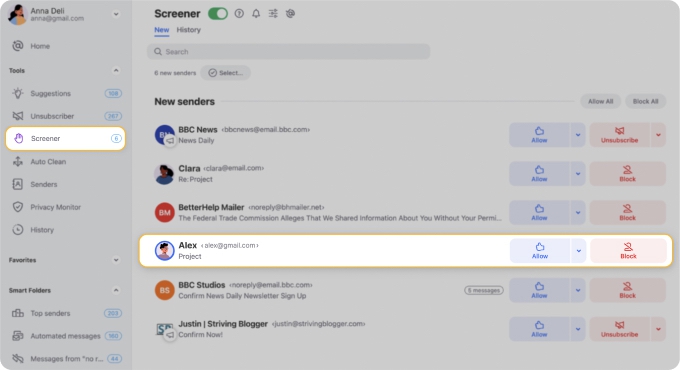
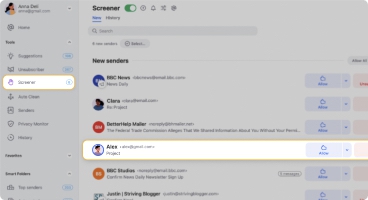
- Flag, Keep Newest, and mark Spam directly from the email list in your Inbox.
- Pin emails from your important senders and view them in the Pinned mailbox.
Conclusion
To reach an Outlook Zero Inbox, you can also stop pointless emails. For instance, if you are working in the same room with someone, get up and speak to them instead of creating another email thread. You can also remove yourself from contact groups or message threads that have gotten too lengthy or gone off-topic.
Now that you know how to get to Inbox Zero using Outlook’s built-in tools and Clean Email’s robust feature set, it’s time to put these tips to work. Once you get into a solid email triage routine, you’ll regain the valuable time you need for other tasks.
Outlook Inbox Zero - FAQs
What is Inbox Zero on Outlook?
Zero Inbox in Outlook is achieved when you have few emails left to organize or sort. You can either end your day with no pending email tasks or have designated only a limited amount of time needed to work on your emails.
Why is my Outlook inbox suddenly empty?
There could be several reasons why your Outlook inbox is suddenly empty, such as an accidental deletion, a misconfigured filter, or a synchronization issue. Check your Deleted Items folder, review your settings, and ensure your account is properly syncing.
How do I get to inbox 0 in Outlook?
To achieve Inbox Zero in Outlook, start marking emails as spam and removing yourself from unwanted mailing lists. You can then use filters and create folders to organize your inbox further.
What is the point of Inbox Zero?
The point of Inbox Zero is to keep your email inbox clear of clutter by promptly processing and organizing messages, which can help reduce stress and increase productivity.


